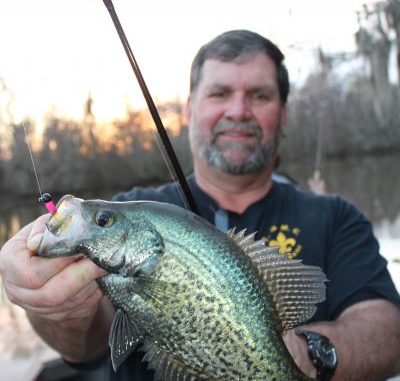
Target clear water for the spawn, angler says
EDITOR’S NOTE: This is the first article in an online series on hot crappie spots across the state that originally appeared in Louisiana Sportsman magazine. Today’s article features information on the Atchafalaya Basin.
Sac-a-lait fishing in February in the Atchafalaya Basin is all about water levels and trying to find clear, still water.
“The fish are wanting to start spawning,” said Keith Thibodeaux, a former bass fisherman who now says sac-a-lait fishing is his passion. “Whether they’ll spawn where we can get to them, or if they’re going to spawn on the back of ridges in the woods, is dependent on the water levels.”
But tight-lining a jig or using a stopper are both effective ways to catch some nice fish right now. Thibodeaux is a fan of the Triple Ripple in black and chartreuse, or the black and limetreuse Bass Assassin.
“I think I can get into tighter structure with the tight-line,” he said. “With tree tops, I’m nearly always tight-lining because I can go into much thicker cover and I can go deeper, then work up to find the fish.
“Plus I just love to feel that thump – it brings me back to my old bass fishing days.”
He likes to work the fallen trees starting in the canal at the tree top, then moving towards shallower water along the bank.
“The majority of your quality fish will be located under the main trunk of the tree, usually mid-length from the roots to the tree top,” Thibodeaux said. “So if your tree is 60-feet long, focus your efforts tight along the tree under the main trunk about 30 feet from the bank.
“That’s where your thickest cover will be, near where those branches would begin.”
Thibodeaux targets sac-a-lait in the 3/4- to 1 ¼-pound range, which he finds more often on the Lake Verret side.
“The Atchafalaya Basin is going to produce greater numbers of fish, but the Lake Verret system will produce better quality, bigger fish,” he said.
In the Lake Verret area, Thibodeaux suggested looking for dead-end canals with no current.
“”I’m going to fish the outer tree tops tight-lined,” he said. “You want a solid bank in the back if you can find it, where the water stays still and warms up faster.
“As the weather warms up and we get closer to March, I’m going to start targeting grass and moving into 3- to 4-feet of water and probably incorporate a stopper and fish jigs like that.”
Bayou Black and canals off of Bayou Penchant are good options, as is the Bayou Long area, or if the water is high, Thibodeaux suggested trying down in the Shell fields north of Flat Lake off of Little Bayou Sorrel. And the Grand River/Pat’s Bay area near Jack Miller’s landing in Plaquemine should be a prime spot, as well.
“I like to fish muddy water during the summer and fall, but in the winter in February and in preparing for the spawn, you want to target clear water for sac-a-lait,” he said.
Wherever and however you fish, Thibodeaux suggested being patient and trying different options before moving to a new spot.
“So many times I’ve gone to an area and started fishing with a certain color or technique and convinced myself the fish weren’t there or weren’t biting,” he said. “Then I go to a tight-line and go down 5 feet and thump a good one.
“My message when you go to an area is to try it all before you give up on it. A lot of times you can stumble onto something that will be very productive.”


